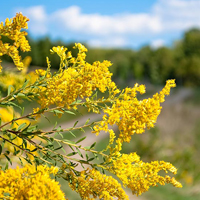Stiff-leaved Showy Goldenrod
Scientific name: Solidago rigidiuscula


Cover photos credit: Allen Woodliffe
Status
Endangered
Endangered
means the species lives in the wild in Ontario but is facing imminent extinction or extirpation.
Date added to the Species at Risk in Ontario list
June 8, 2011
Read the Assessment report
On January 26, 2022, the common and scientific names of this species were updated on the Species at Risk in Ontario list from Showy Goldenrod (Great Lakes Plains population) (Solidago speciosa) to Stiff-leaved Showy Goldenrod (Solidago rigidiuscula) to be consistent with recent nomenclatural and taxonomic changes. The species’ name change does not change the protections afforded to the species under the Endangered Species Act, 2007 (ESA) or the applicability of any policies, permits and agreements, guidance documents or best management practices that may have been published or issued by the Government of Ontario in respect of the species.
What it looks like
Stiff-leaved Showy Goldenrod is a large perennial belonging to the aster family. It can grow to two metres in height. It has large, toothed, egg-shaped lower leaves and much smaller more smooth-edged upper leaves.
Stiff-leaved Showy Goldenrod typically has numerous upright, unbranched stems rising from a central clump. The small yellow flowers form a cylindrical cluster along the upper 30 centimetres of the stem.
Where it lives
Stiff-leaved Showy Goldenrod is widespread in the eastern United States, ranging from New Hampshire west to Wyoming, and south to New Mexico and the Gulf states. In Canada, this species is restricted to southwestern and northwestern Ontario.
These habitats are kept in an open condition by frequent fires.
Where it’s been found in Ontario
Stiff-leaved Showy Goldenrod is widespread in the eastern United States, ranging from New Hampshire west to Wyoming, and south to New Mexico and the Gulf states. In Canada, this species is restricted to southwestern and northwestern Ontario.
In southwestern Ontario, there are two populations on Walpole Island First Nation in Lambton County, which contained approximately 800 plants in 2008.
What threatens it
The main threat to Stiff-leaved Showy Goldenrod is habitat destruction due to development together with agricultural expansion.
Other threats include damage to plants from pedestrian and ATV traffic, and competition from invasive plants such as European Common Reed (Phragmites australis spp. australis) and White Sweet Clover (Melilotus alba).
A limiting factor for this species is the decline in tallgrass prairie and savannah habitat in southern Ontario.
Action we are taking
Endangered species and their habitat are protected.
Recovery strategy
A recovery strategy advises the ministry on ways to ensure healthy numbers of the species return to Ontario.
Read the executive summary (January 28, 2016)
Read the recovery strategy (January 28, 2016)
Government response statement
A government response statement outlines the actions the government intends to take or support to help recover the species.
Read the government response statement for the Great Lakes Plains population (October 28, 2016)
Review of Progress
A review of progress made toward protecting and recovering a species is required no later than the time specified in the species’ government response statement, or not later than five years after the government response statement is published if no time is specified.
Read the report on progress towards the protection and recovery of 18 species at risk, including Stiff-leaved Showy Goldenrod (under its former name of Showy Goldenrod – Great Lakes Plains population) (2021).
Habitat protection
General Habitat Protection - June 8, 2011
What you can do
Report a sighting
- Report a sighting of an endangered animal or plant to the Natural Heritage Information Centre. Photographs with specific locations or mapping coordinates are always helpful.
Volunteer
- Volunteer with your local nature club or provincial park to participate in surveys or stewardship work focused on species at risk.
Be a good steward
- Private land owners have a very important role to play in species recovery. If you find Stiff-leaved Showy Goldenrod on your land, you may be eligible for stewardship programs that support the protection and recovery of species at risk and their habitats.
- Invasive species seriously threaten many of Ontario’s species at risk. To learn what you can do to help reduce the threat of invasive species, visit:
- Stiff-leaved Showy Goldenrod and many other species at risk depend on healthy grassland prairies, a rare habitat in Ontario. Learn more about these habitats, the species that depend on them, and what you can do to help at: Tallgrass Ontario
- Pollinators, such as bees, are in steep decline across the globe and they play a key role in the survival of many of Ontario’s rare plants. For information on how you can help scientists monitor pollinator populations in Ontario visit: Seeds of Diversity
Report illegal activity
- Report any illegal activity related to
1-866-MOE-TIPS (663-8477) .
Quick facts
- The root of this species was used by Aboriginal people for burns, strained muscles, trouble breathing and difficult labour.